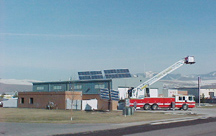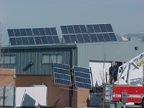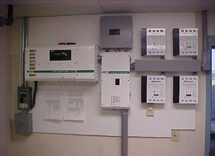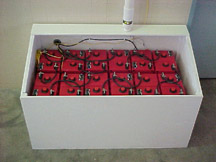|
SOLAR
POWER
Missoula
Fire Station Goes Solar�
May
Be First Such Grid-intertied PV System
By Ed
Brunsvold, Firefighter�
 Missoula
Fire Station No. 4 is the first in Montana to be partially
solar powered. (I�d also be willing to wager that it is
the first municipal station to be grid intertied in the
country, but I'd also be delighted to find out I�m wrong.) Missoula
Fire Station No. 4 is the first in Montana to be partially
solar powered. (I�d also be willing to wager that it is
the first municipal station to be grid intertied in the
country, but I'd also be delighted to find out I�m wrong.)
It is estimated that the system will produce approximately
6,500kwh of electricity each year. The system is primarily a
grid intertie system, with battery backup. Power stored in
the battery bank is used only in the event of a power outage
and powers circuits critical for the station�s operations.
Best of all, we think that it is firefighter proof (meaning
it is indestructible and low maintenance.)
The system was funded through a $50,000 grant from the
Universal System Benefits Charge, administered by Montana
Power Company.
Sunelco
of Hamilton, Montana, installed the system. It became
operational in March 2001. The grant proposal basically
wrote itself. The combination of a good solar site, and a
classroom in the building, made the fire station a good
candidate.
 The
savings in energy costs benefit the local taxpayers, and we
can train firefighters how to work safely around renewable
energy systems. As these systems become more prevalent,
firefighters will need to recognize when a building�s
electrical circuits are de-energized. Other agencies such as
schools and folks in the electrical trades can also use the
classroom to get familiar with solar components. The
savings in energy costs benefit the local taxpayers, and we
can train firefighters how to work safely around renewable
energy systems. As these systems become more prevalent,
firefighters will need to recognize when a building�s
electrical circuits are de-energized. Other agencies such as
schools and folks in the electrical trades can also use the
classroom to get familiar with solar components.
The system is wired in a 48-volt configuration. (See
the PV System Key below). The system consists of 40
Kyocera 120 watt panels, 32 of which are roof mounted and 8
that are pole mounted on a Zomeworks tracker. Although it is
questionable whether or not a tracker makes sense in
Montana, we wanted to demonstrate various components and
have some of the panels accessible without going up on the
roof.
 Power
is routed through four RV Solar Boost 3048 charge
controllers, which keep the batteries topped off. The
majority of the power is then inverted to 120-volt AC through a
Trace 4048 inverter and made available for the station�s
demand. When electricity generated is in excess of the
station�s demand, the inverter sends the power to the
utility grid, causing the electrical meter to spin
backwards. This is a rare occurrence, as the fire station
was designed in times of regulated and plentiful
electricity. Power
is routed through four RV Solar Boost 3048 charge
controllers, which keep the batteries topped off. The
majority of the power is then inverted to 120-volt AC through a
Trace 4048 inverter and made available for the station�s
demand. When electricity generated is in excess of the
station�s demand, the inverter sends the power to the
utility grid, causing the electrical meter to spin
backwards. This is a rare occurrence, as the fire station
was designed in times of regulated and plentiful
electricity.
The station uses fluorescent lighting and compact
fluorescent bulbs, but it uses electric heat in the public
bathrooms and has a complex HVAC system. I just hope that I�m
around when Missoula designs its next station!
 The battery bank consists of 12 Surrette 4KS � 21PS
4-volt batteries wired in series for 1104 amp hours at 48
volts. It will easily supply circuits critical for station
operation � including door openers, radios, some lighting,
and the computer � for up to six hours. When the inverter
senses a power outage, it draws power from the batteries as
needed. In the case of an extended outage, the station
relies on an auxiliary diesel generator. The battery bank consists of 12 Surrette 4KS � 21PS
4-volt batteries wired in series for 1104 amp hours at 48
volts. It will easily supply circuits critical for station
operation � including door openers, radios, some lighting,
and the computer � for up to six hours. When the inverter
senses a power outage, it draws power from the batteries as
needed. In the case of an extended outage, the station
relies on an auxiliary diesel generator.
Missoula is a pretty green city, and the city government
and administration mirror that in their policies supporting
renewable energy, conservation, and efficiency. The Mayor�s
car is a Toyota Prius, but you�re just as likely to see
him about town on foot or on a bike.
Missoula Fire Department welcomes visitors to stop by to
see the system during daytime hours, and when the crew is in
quarters. Please don�t expect the on-duty firefighters to
answer all your questions about the system. A handout sheet
is available at the station, and a system component diagram
is posted in the inverter room.
For more information about the project at the station,
contact Ed Brunsvold at [email protected].
For technical information about solar components, contact
Sunelco in Hamilton at www.sunelco.com.
Ed
Brunsvold photos
Missoula
Fire Station #4
Photovoltaic System Key
- AC kWh meter
� Displays the energy production of
the PV system
- Inverter AC input/output disconnect & bypass
breaker box
� Provides a means to disconnect the
AC input & output to the SW4048 inverter. This
disconnect also provides an easy manual means to route
utility power around the inverter (in the case of a system
failure) and supply 120 VAC power to the AC sub panel.
- Trace SW4048 inverter
� Converts DC power from
the 48V solar array and/or battery bank to 120 VAC power
to be used in the 120 VAC sub panel located in the utility
room behind the office
- Trace DC175 disconnect
� Provides the NEC
required main disconnect and overcurrent protection for
the circuit connecting the battery bank to the SW4048
inverter.
- Trace PVGFP3 ground fault protection device
-
Provides the NEC required ground fault protection for a
roof mounted solar array.
- RV Power Products SB3048 Maximum Power Point Tracking
(MPPT) charge controller
� This controller
maximizes the output from the solar array while preventing
the batteries from being over charged by the solar array.
- RV Power Products SB3048 Maximum Power Point Tracking
(MPPT) charge controller
� This controller
maximizes the output from the solar array while preventing
the batteries from being over charged by the solar array.
- RV Power Products SB3048 Maximum Power Point Tracking
(MPPT) charge controller
� This controller
maximizes the output from the solar array while preventing
the batteries from being over charged by the solar array.
- RV Power Products SB3048 Maximum Power Point Tracking
(MPPT) charge controller
� This controller
maximizes the output from the solar array while preventing
the batteries from being over charged by the solar array.
- Surrette battery bank consisting of twelve 4KS-21PS 4V
1104 amp-hour batteries
� This battery bank is
maintained at a float charge by the solar array and can
provide backup power to the 120 VAC sub panel in the event
of an extended utility power outage.
- Outdoor Solar AC disconnect
� Provides the NEC
required AC disconnect in between the utility main AC
panel and the SW4048 inverter�s AC input. This AC
circuit is bi-directional (input & sell) so this
disconnect would allow a utility worker to quickly
disconnect the AC power that the PV system is sending back
to the main AC panel if they need to do any work on the
line.
- 120 VAC sub panel
� New sub panel installed in
the room behind the office that contains the critical
loads that the system powers in the event of an extended
utility outage.
Back
to the top
|